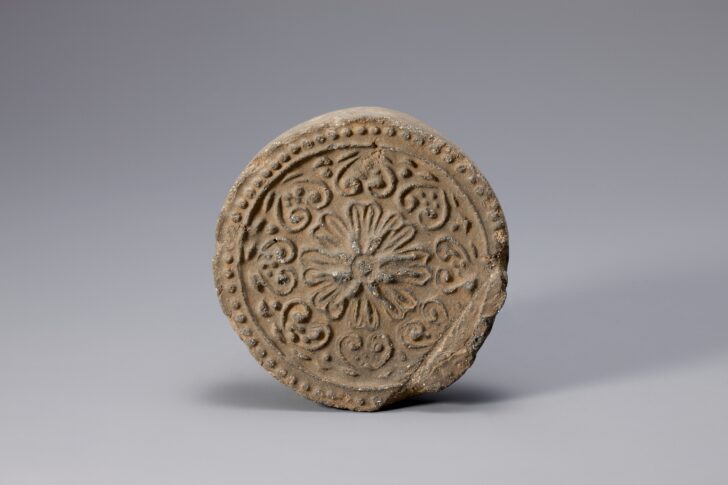Roof Tile-End with Lotus and Bosanghwa Design
Korean

Description
March 28, 2009
Two types of tiles were used in the construction of traditional ceramic roof structures in Korea. One type, called ammaksae, was flat with a slight curve in the cross-section. It was placed concave side up, directly on top of the roof supports. The other type, called sumaksae, was semicylindrical and placed convex side up to cover the joined edges of the flat ammaksae tiles. When completely in place on a roof, ammaksae tiles alternated with rows of sumaksae. Rain rolled off the curved spine of the sumaksae rows and ran down the gutters formed by the ammaksae tiles. The terminal ends of both the ammaksae and sumaksae rows were capped by tile-ends, which were usually decorated and visible on the edge of the eaves. A crescent-shaped tile-end capped the ammaksae row, while a round tile-end capped the end-tile on a sumaksae row.
The Buddhist lotus, readily adapted into a medallion shape, became the favored motif for decorating sumaksae end-tiles after Korea’s adoption of Buddhism in the fourth century. At first the lotus medallion was simple: the seedpod contained few seeds, the petals were few, and their forms were wide and fleshy. Toward the end of the Three Kingdoms period, the lotus design became more complex and linear and the petals more narrow and flat. In the Unified Silla period that followed, other floral medallions were introduced. The lotus often appeared in combination with a bosanghwa (precious visage) motif, a stylized floral pattern that symbolized the sanctity of Buddhism. The bosanghwa motif on these tiles appears as a stylized heart shape outside the central lotus and could easily be mistaken for a yeoui (scepter-head) pattern, another Buddhist-derived motif. Thousands of these Unified Silla circular tile-ends have been unearthed at the Pond of Geese and Ducks (Anapji), a man-made water feature that was part of a large-scale pleasure resort in Gyeongju, the Silla capital.
(Label for UMMA Korean Gallery Opening Rotation, March 2009)
Subject Matter:
Tile-end used to cap a sumaksae row of cylindrical roof tiles.
Physical Description:
Circular earthenware tile with molded lotus and bosangwha design.
This dark gray, high-fired earthenware convex eave-end roof tile is decorated with an eight-petal lotus floral medallion. It is made from coarse clay mixed with fine stone particles. The center of the tile is decorated with a double-petaled lotus flower surrounded by eight heart-shaped palmette petals (bosanghwa ) in low relief. Traces of clay used to attach this tile to a flat tile can also be seen on the joints of the reverse side.
[Korean Collection, University of Michigan Museum of Art (2017) p. 39]
Usage Rights:
If you are interested in using an image for a publication, please visit https://umma.umich.edu/request-image/ for more information and to fill out the online Image Rights and Reproductions Request Form.